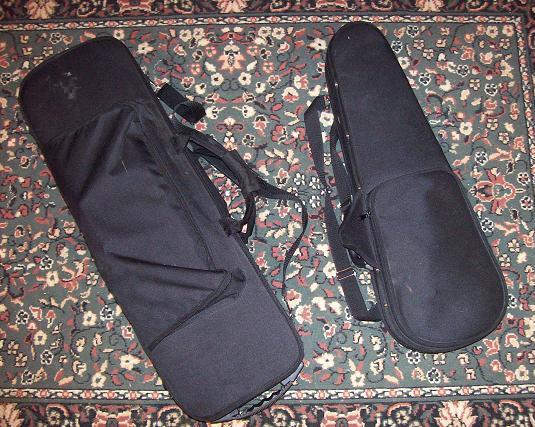|
TVG's Violin Case Guide
When you buy a student violin, the violin case will probably be part of the outfit. If you get to choose, here is a brief introduction to violin cases, what is available and what to look for. Shape There are two basic shapes of case, the dart shape and rectangular shape. (and some minor variations on each theme.) The dart shaped cases occupy the lower end of the price spectrum. They offer space for a couple of bows, a spot for rosin, and a shoulder rest can be squeezed in if you are imaginative. The ones that come with pockets are not offering anything terribly useful as you cannot fit a sheet of music in the pocket. 
One of the more interesting violin cases I have seen are the SKB cases with the storage compartment at the opposite end than usual which provides a lot more space for storing a shoulder rest, along with the robust construction their manufacturer promotes. The rectangular violin cases are usually favoured by advancing musicians, as they offer much more storage and other facilities. Space for bows, holders for spare strings , pockets for music that are actually big enough to use, and space for shoulder rests are all standard. The other features you will come across are hygrometers and humidifiers for monitoring and controlling the humidity level in your case. In areas that experience large changes in humidity, or when traveling between places with large variations in humidity, the changes can put quite a strain on a wooden instrument like the violin. A humidifier in the violin case is an attempt to reduce this strain. For student instruments I wouldn't be too concerned about humidifiers. Other features Suspension system. Most cases will come with a suspension system that keeps the bottom of the violin off the case. The intention is to reduce the risk of damage if the case is knocked. The system usually consists of padding at each end of the body of the violin, and at the scroll. Robustness. Of course cases vary wildly in how strong they are, varying from polystyrene cases designed solely for shipping, through light wooden plywood construction, thermoplastic and Carbon fiber. Cheaper cases will also use cheaper construction and are going to need replacing more often Water/weather proofing. You may want to consider how water/weather tight your case is. This will be more of an issue if you are having to carry it while traveling in the open. Most cases are at least water repellant. Weight. Again, if you are going to have to carry your instrument a lot, how much extra weight do you want to handle. The cases can vary a lot in weight, and what is light to carry for 10 minutes, may not be after half an hour! Price. Basically you can pay as much as you want, ranging from USD$35 ish at the low end, up to the 'Cadillac' of violin cases, made by Musafia. Yes, you too can be the proud owner of a violin case that costs more that the majority of violins in the world. Back to the Violin Accessory page.
|